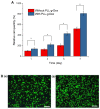Fluorescent DNA Biosensor for Single-Base Mismatch Detection Assisted by Cationic Comb-Type Copolymer
- PMID: 30764576
- PMCID: PMC6384784
- DOI: 10.3390/molecules24030575
Fluorescent DNA Biosensor for Single-Base Mismatch Detection Assisted by Cationic Comb-Type Copolymer
Abstract
Simple and rapid detection of DNA single base mismatch or point mutation is of great significance for the diagnosis, treatment, and detection of single nucleotide polymorphism (SNP) in genetic diseases. Homogeneous mutation assays with fast hybridization kinetics and amplified discrimination signals facilitate the automatic detection. Herein we report a quick and cost-effective assay for SNP analysis with a fluorescent single-labeled DNA probe. This convenient strategy is based on the efficient quenching effect and the preferential binding of graphene oxide (GO) to ssDNA over dsDNA. Further, a cationic comb-type copolymer (CCC), poly(l-lysine)-graft-dextran (PLL-g-Dex), significantly accelerates DNA hybridization and strand-exchange reaction, amplifying the effective distinction of the kinetic barrier between a perfect matched DNA and a mismatched DNA. Moreover, in vitro experiments indicate that RAW 264.7 cells cultured on PLL-g-Dex exhibits excellent survival and proliferation ability, which makes this mismatch detection strategy highly sensitive and practical.
Keywords: SNP analysis; cationic comb-type copolymer; fluorescent DNA biosensor; graphene oxide; single-base mismatch detection.
Conflict of interest statement
The authors declare no conflict of interest.
Figures






Similar articles
-
Novel analysis for single nucleotide polymorphism using cationic comb-type copolymers.Nucleic Acids Symp Ser (Oxf). 2007;(51):339-40. doi: 10.1093/nass/nrm170. Nucleic Acids Symp Ser (Oxf). 2007. PMID: 18029725
-
Analysis of cationic comb-type copolymers/DNA interaction by the single molecular observation and intermolecular force measurement.Nucleic Acids Symp Ser (Oxf). 2008;(52):715-6. doi: 10.1093/nass/nrn361. Nucleic Acids Symp Ser (Oxf). 2008. PMID: 18776580
-
Single-base mismatch recognition using partially double-stranded probes having various lengths.Nucleic Acids Symp Ser (Oxf). 2006;(50):325-6. doi: 10.1093/nass/nrl162. Nucleic Acids Symp Ser (Oxf). 2006. PMID: 17150949
-
The effect of backbone structure on polycation comb-type copolymer/DNA interactions and the molecular assembly of DNA.Biomaterials. 2005 Mar;26(7):703-11. doi: 10.1016/j.biomaterials.2004.03.018. Biomaterials. 2005. PMID: 15350774
-
Optical detection of DNA and proteins with cationic polythiophenes.Acc Chem Res. 2008 Feb;41(2):168-78. doi: 10.1021/ar700115t. Epub 2008 Jan 17. Acc Chem Res. 2008. PMID: 18198841 Review.
Cited by
-
Biosensors: Electrochemical Devices-General Concepts and Performance.Biosensors (Basel). 2022 Dec 28;13(1):44. doi: 10.3390/bios13010044. Biosensors (Basel). 2022. PMID: 36671878 Free PMC article. Review.
-
Biosensors for Point Mutation Detection.Front Bioeng Biotechnol. 2021 Dec 15;9:797831. doi: 10.3389/fbioe.2021.797831. eCollection 2021. Front Bioeng Biotechnol. 2021. PMID: 34976987 Free PMC article. No abstract available.
-
Chaperone Copolymer-Assisted Catalytic Hairpin Assembly for Highly Sensitive Detection of Adenosine.Polymers (Basel). 2024 Jul 31;16(15):2179. doi: 10.3390/polym16152179. Polymers (Basel). 2024. PMID: 39125205 Free PMC article.
-
Cationic copolymers that enhance wild-type-specific suppression in BNA-clamp PCR and preferentially increase the T m of fully matched complementary DNA and BNA strands.Biol Methods Protoc. 2022 Mar 30;7(1):bpac009. doi: 10.1093/biomethods/bpac009. eCollection 2022. Biol Methods Protoc. 2022. PMID: 35664806 Free PMC article.
References
MeSH terms
Substances
Grants and funding
LinkOut - more resources
Full Text Sources
Other Literature Sources

